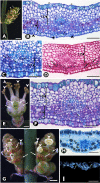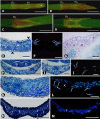Heterochrony and repurposing in the evolution of gymnosperm seed dispersal units
- PMID: 35172885
- PMCID: PMC8851845
- DOI: 10.1186/s13227-022-00191-8
Heterochrony and repurposing in the evolution of gymnosperm seed dispersal units
Abstract
Background: Plant dispersal units, or diaspores, allow the colonization of new environments expanding geographic range and promoting gene flow. Two broad categories of diaspores found in seed plants are dry and fleshy, associated with abiotic and biotic dispersal agents, respectively. Anatomy and developmental genetics of fleshy angiosperm fruits is advanced in contrast to the knowledge gap for analogous fleshy structures in gymnosperm diaspores. Improved understanding of the structural basis of modified accessory organs that aid in seed dispersal will enable future work on the underlying genetics, contributing to hypotheses on the origin of angiosperm fruits. To generate a structural framework for the development and evolution of gymnosperm fleshy diaspores, we studied the anatomy and histochemistry of Ephedra (Gnetales) seed cone bracts, the modified leaves surrounding the reproductive organs. We took an ontogenetic approach, comparing and contrasting the anatomy and histology of fleshy and papery-winged seed cone bracts, and their respective pollen cone bracts and leaves in four species from the South American clade.
Results: Seed bract fleshiness in Ephedra derives from mucilage accumulated in chlorenchyma cells, also found in the reduced young leaves before they reach their mature, dry stage. Cellulosic fibers, an infrequent cell type in gymnosperms, were found in Ephedra, where they presumably function as a source of supplementary apoplastic water in fleshy seed cone bracts. Papery-winged bract development more closely resembles that of leaves, with chlorenchyma mucilage cells turning into tanniniferous cells early on, and hyaline margins further extending into "wings".
Conclusions: We propose an evolutionary developmental model whereby fleshy and papery-winged bracts develop from an early-stage anatomy shared with leaves that differs at the pollination stage. The ancestral fleshy bract state may represent a novel differentiation program built upon young leaf anatomy, while the derived dry, papery-winged state is likely built upon an existing differentiation pattern found in mature vegetative leaves. This model for the evolution of cone bract morphology in South American Ephedra hence involves a novel differentiation program repurposed from leaves combined with changes in the timing of leaf differentiation, or heterochrony, that can further be tested in other gymnosperms with fleshy diaspores.
Keywords: Bracts; Cellulosic fibers; Fruit-like; Gnetales; Gymnosperm; Heterochrony; Histochemistry; Mucilage; Ontogeny; Seed dispersal.
© 2022. The Author(s).
Conflict of interest statement
The authors declare that they have no competing interests.
Figures









Similar articles
-
The earliest fleshy cone of Ephedra from the early cretaceous Yixian Formation of northeast China.PLoS One. 2013;8(1):e53652. doi: 10.1371/journal.pone.0053652. Epub 2013 Jan 14. PLoS One. 2013. PMID: 23341964 Free PMC article.
-
Fleshy or dry: transcriptome analyses reveal the genetic mechanisms underlying bract development in Ephedra.Evodevo. 2022 Apr 27;13(1):10. doi: 10.1186/s13227-022-00195-4. Evodevo. 2022. PMID: 35477429 Free PMC article.
-
Detailed seed cone morpho-anatomy of the Prumnopityoid clade: an insight into the origin and evolution of Podocarpaceae seed cones.Ann Bot. 2022 Nov 17;130(5):637-655. doi: 10.1093/aob/mcac097. Ann Bot. 2022. PMID: 35906916 Free PMC article.
-
Fruit aromas in mature fleshy fruits as signals of readiness for predation and seed dispersal.New Phytol. 2013 Jan;197(1):36-48. doi: 10.1111/j.1469-8137.2012.04382.x. Epub 2012 Nov 5. New Phytol. 2013. PMID: 23127167 Review.
-
Evolution of angiosperm seed disperser mutualisms: the timing of origins and their consequences for coevolutionary interactions between angiosperms and frugivores.Biol Rev Camb Philos Soc. 2016 Feb;91(1):168-86. doi: 10.1111/brv.12164. Epub 2014 Dec 20. Biol Rev Camb Philos Soc. 2016. PMID: 25530412 Review.
References
-
- Mapes G, Rothwell GW, Haworth MT. Evolution of seed dormancy. Nature. 1989;337:645–646. doi: 10.1038/337645a0. - DOI
-
- Traveset A, Rodríguez-Pérez J. Seed dispersal. In: Jørgensen SE, Fath BD, editors. Encyclopedia of ecology. Oxford: Academic Press; 2008. pp. 3188–3194.
-
- Nigris S, D’Apice G, Moschin S, Ciarle R, Baldan B. Fleshy structures associated with ovule protection and seed dispersal in gymnosperms: a systematic and evolutionary overview. Crit Rev Plant Sci. 2021 doi: 10.1080/07352689.2021.1938397. - DOI
Grants and funding
LinkOut - more resources
Full Text Sources
Miscellaneous

